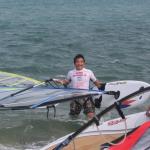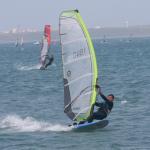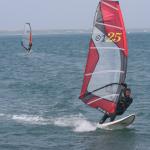Wind Warriors of The Pescadores
It's eight AM on the first day of the sixth annual Penghu ProAm windsurfing tournament, the first stop on the 2006-2007 Asian Windsurfing Tour, and the event promises to be a veritable sailing whirlwind. The crème de la crème of the windsurfing world are gathered by the harbor, preparing to do precisely what sixties mystic troubadour Donavan once advised against; to try and catch the wind. The sun is bright, there isn't a cloud in the sky, and the archipelago halfway between Taiwan and the Chinese mainland, statistically among the windiest places on the planet, seems custom made for competition windsurfing.
But by the water the faces of the sailors show concern, for one crucial element has failed to appear in expected quantity: wind.
"Last year at this time the winds would've blown your tits off, they were forty, maybe fifty knots," says Dirk Michielsen, a Belgian designer of sports eyewear who's made his home in central Taiwan for over a decade. "But this year, ach, it's strange. There's no wind."
"No wind" isn't quite accurate. There's a fairly steady breeze of perhaps 15 knots blowing in from the Chinese mainland. But on Penghu, where farmers encircle their fields with walls made of interlocked coral to protect their peanut crops from being blown away and wind speeds that would send most Middle Americans running for the root cellars are the norm, 15 knot winds barely register as a breeze.
"Anywhere else in the world this'd be considered excellent windsurfing conditions." Says Larry Davis, a long-time island resident slated to compete at the Masters level.
"But in Penghu, windsurfers call this bicycling weather."
Weather is a fickle mistress, and for windsurfers this can be especially frustrating. Wind, unlike snow, cannot be manufactured. For this reason, professional windsurfing circuit events generally last ten days. But the Penghu Pro-am, an event that brings professionals and amateurs windsurfers together, is a three day event. While the professionals have sponsorship, equipment makers like Neilpryde, Starboard and AB+, most amateurs find taking ten days off to chase the wind an impossible luxury. Before the events are slated to begin, local event organizers, who have a vested interest in making the name Penghu synonymous with windsurfing, head down to the nearby Matsu temple and make offerings of pork, chicken and fish to the goddess of the sea.
Perhaps the supernatural offerings are to thank; obviously there are more scientific expiations. Regardless, by 9 AM the winds have picked up enough to make competition possible. An announcement comes over the loudspeakers, first in Mandarin, then in English, and the first round of competitors sprint for the water carrying their rigs. Once immersed, the sailors hover next to their boards, waiting for the shrill blast of the air horn that will announce that the first heat, which, wind permitting, will be the first of many, is on.
The first heat is a slalom run, its competitors big name sailors of the windsurfing world like Swede Anders Brigndal and Austrian Chris Pressler. The shrill sound of the starting air horn is followed quickly by a second sound, this one the galvanic crackle of sails inflating, straining against carbon fiber frames held fast by champion riders. Organizers and future competitors alike gather on the beach to watch as these champions of the windsurfing world attempt to outdo each other in a completion in which they'll be judged both on speed and grace. After five slalom runs, clear winners emerge, and first place is taken by Australian Jesper Orth, with second and third going, not surprisingly, to Brigndal and Pressler respectively.
After the event, Pressler, who is in Penghu for the first time, seems pleased with his performance, and says that the unexpectedly low winds should not detract from the overall competition. "Everybody competes in the same wind," says the Austrian. "These conditions are excellent for kinds of sailing that higher winds would make impossible, and I think a lot of the less experienced sailors will find them ideal." Nonetheless, Pressler says he is eager to test his skills against higher winds; he has already made arrangements to stay after the end of the three day competition to take advantage of the extreme winds which should come to Penghu ahead of a forecasted typhoon moving towards the Philippines in the next week.
Anders Bringdal is also planning to stick around to test his skill against the coming high winds. "Really the optimum speed for windsurfing is 30 knots," says Anders Bringdal, who came equipped for higher winds. "Once you get above that, it's a shit fight, you need a small sail to keep stable." Though he's done well with his borrowed lower-wind board and sail, Bringdal seems eager to test his own high-wind equipment in the coming storm.
Professional windsurfers aside, most who have gathered in Penghu for what they hope will be three days of sun and high winds are talented amateurs, devotees of the sport who've come from across the globe. One group of Russian surfers hails from Vladivostok, Russia's windsurfing capitol, where cold winds make sailing without a wetsuit impossible for most of the year, and seem happy just to be wearing shorts and tank-tops in late November. There are also a few competitors from Hong Kong. Kowloon native Chou Siang Min, who winds up earning a respectable 3rd place showing in beginner's slalom, has been to Penghu many times. "Hong Kongers mostly train in Sai Kung," says Chou, "but anyone serious about windsurfing in the region needs to come to Penghu."
Wind conditions combined with equipment limitations conspire to keep some from competing entirely. Dirk Michielsen says he expected last years 30 knot winds, and came prepared accordingly. "You need high winds to push a 6.6 meter sail and narrow board like mine," Says Michielson. "I even brought my 5.1 meter sail in case it got higher, but in a breeze like this I'd sink like a stone with that kind of gear."
Nowhere else is matching gear to wind conditions as crucial as in competition windsurfing, where having just the right size sail, or perfectly suited board can make a huge difference in speed. Though an asset in high winds, a smaller sail doesn't allow for enough forward velocity in a low-to-medium blow. Even variations over the short run (like, say in the course of an individual slalom heat) forces each sailor to make constant adjustments to their individual sailing techniques. Though the winds generally stay in the high teens for most of the morning, even gusting into the twenties at times, there are still periods when riders mid-heat find themselves faced with brief lulls. A sailor in this situation does whatever they can to keep themselves upright, jerking the sail like the handle of a water pump.
But occasionally the opposite happens; a sudden gust catches sails flagging mid-heat with a series of electric cracks, and within seconds boards, sails and sailors are skipping across the surface of the water like flat stones. From that moment, the race is truly on, and as long as the wind keeps up, and again, remember the words of Chris Pressler, that all sailors share the same wind, the competition is entirely about each individuals skill and instinct.
Handling the board, knowing precisely how to tilt the sail to achieve maximum speed without sacrificing stability, is at the heart of competition windsurfing. Watching equally matched sailors compete in a slalom heat, one can't help but be reminded of world-class track bike racers competing in a velodrome, each racer cyclist a course within a narrow band, tilting to shave inches and seconds off their end speeds.
But the crucial difference comes in strategy; whereas a cyclist knows the benefit of dogging an opponent, of conserving energy by drafting in a fellow rider's wake before passing at a crucial moment, in competition windsurfing the strategy is almost entirely opposite. For nothing will kill a sailor's speed more surely than getting too close behind a fellow sailor at the wrong angle. A talented sailor with a slight distance edge can capitalize on this, especially while cornering around the buoy demarcating the turnaround point for the slalom course - in sailing parlance, this is called jibbing. With the right timing, the lead sailor can literally take the wind from the sails of the trailing sailor; the effects are instant, and often devastating. During the morning slalom runs on the first day at Penghu, more than one trailing sailor finds their sails deflated by the lead sailor rounding the curve. The move is known as "rolling your opponent," and the sailor who's been rolled knows they're in trouble.
Windsurfing is not an old sport, at least not professionally. Whereas it's well known in the surfing world that tribesmen on various Pacific islands took to the notion of standing upright on crude board hewn from tree trunks long before the phrase "hang ten" was ever uttered, the combination of surfing and sailing is something that really only came out in the latter half of the 20th century. The first windsurfing boards looked, more or less, like the mutant offspring of a regular longboard and a small sailboat. Cumbersome and difficult to master, the sport nonetheless attracted enough devotees to encourage the development of lighter, faster, and easier to handle equipment. encouraging more neophytes to take to the wind and waves.
Technological breakthroughs have made windsurfing accessible to those who might otherwise be intimidated by the taken martial arts devotion mastering the sport might have taken in decades past; nowadays the tourist can come to a place like Penghu and, after a few hours in the water with a moderate breeze and a good instructor like Alex Mowday, who operates Liquid Sports, Penghu's oldest windsurfing club & pro shop, should be able to harness the wind well enough to want to keep coming back.
"The equipment is better, and beginner boards are wider, more stable," says Mowday. "In Taiwan, the sport is really picking up."
Considering the fact that, during the days of martial law, and even for several years after, private sailing vessels were forbidden by law, water sports in general have come a long way in Taiwan. Nowadays surfers are a common site on Taiwan's east coast beaches; two decades ago the few westerners brave or foolish enough to attempt to surf in Taiwan often found their fun curtailed by warning shots from an ROC coast guard boat. That the local government of a key strategic area like Penghu should be so enthusiastic about promoting windsurfing on the island is a good indicator of just how far the ROC government has stepped away from its traditional defensive war footing.
Penghu has another potential ally in its bid for international recognition as a windsurfing training grounds, albeit one not old enough to shave. At 16, Penghu native Chang Hao already shows many of the hallmarks of a champion. With a lithe, compact frame built for speed and an islander's instinct for the water, Chang Hao handily beats old older, more experienced sailors to take the gold in the morning Masters section on the first day. The buzz locally and on the circuit is that Chang Hao is a sure pick for either the 2012 Olympics, and possibly even the 2008 competition, which is to be held in Qingdao. If true, if this native of Penghu gets the chance to go for the gold on the international stage, Penghu's position as a world class windsurfing training grounds, on par with the Canary Islands or Hawaii, seems assured. Chang Hao, who has already traveled internationally for the sport, takes it for granted that his home island is well on its way to sailing fame.
"Penghu is better than the Canary Islands, and once word gets out windsurfers will be coming here in greater numbers, to train and to compete."
It's a brash statement, based at least partially on local pride. But it isn't necessarily untrue. Penghu is perfectly suited for windsurfing, thanks to its fengshui - in the most literal sense. The three main islands of the archipelago, flat stretches of land connected by bridges, form a near-perfect horseshoe, with two narrow inlets to the north and one wider one to the south. The arrangement combines perfectly with the prevailing - and usually fierce - winds blowing from north to south, and for most windsurfers, this would be enough.
But for the true speed chasers, Mother Nature herself requires occasional augmentation. Enter the trench.
The trench is basically what it sounds like, a smoothed underwater channel constructed to provide ideal conditions for speed sailing. The local government is currently considering constructing one on one stretch of beach on the east side of Penghu's main island. If completed, it's hoped that the trench will become a magnet for the sailors seeking the holy grail of sailing - the thus far elusive speed of 50 knots (the current record, held by Irishman Finian Maynard, is 48.7 knots). Conditions need to be absolutely ideal to allow for this degree of speed, and the water must be absolutely smooth. To facilitate this, a section of the ground beneath is flattened and maintained regularly. Very few areas offer facilities like this for sailors, and by doing so Penghu hopes to increase its profile in the sailing world.
But terraformed ocean floor and just-right winds aside, no record can be set without a champion sailor equipped with the right rig. In a way, both the current competition and the speed trench project is a lure to try to entice the best in the sport to help transform this barely-known vacation archipelago into a serious destination for water sport enthusiasts. Clearly the local government, already considering a number of schemes to vastly raise Penghu's profile as potential vacation destination, chief among them less wholesome offerings, such as 24-hour casinos and legalized gambling, is looking at the wind as a major draw.
"We've always made good use of the wind, what with our windmills and so forth," says Caroline Lee, a bilingual young Penghu native acting as a liaison and coordinator for the event. "Its only natural that we should use this asset to attract windsurfers."
Luckily for all involved, Penghu has other assets besides wind, because by the end of the afternoon Matsu seems to have all but shut the tap, and the forecast for the next two days calls for calm wind and clear skies. While today has been one of judged and scored competitions, it's likely that the next two will consist of just-for-fun, non-scoring events. The assembled windsurfers, some of whom have either been on Penghu for several windy days prior to the competition, and others who are planning to stay for the very promising storm currently heading in from the east, take it in stride.
"This is part of the sport," says Russian Igor Balabashir. "When there is no wind, we wait."
"Sometimes we play volleyball," Adds countryman Yuri Markedonski.
"Also, we drink."
* * *
Originally ran as "Wind Warriors," HK Weekend Standard, December 16th, 2006.
* * * * *
 ThingsAsian
ThingsAsian


















